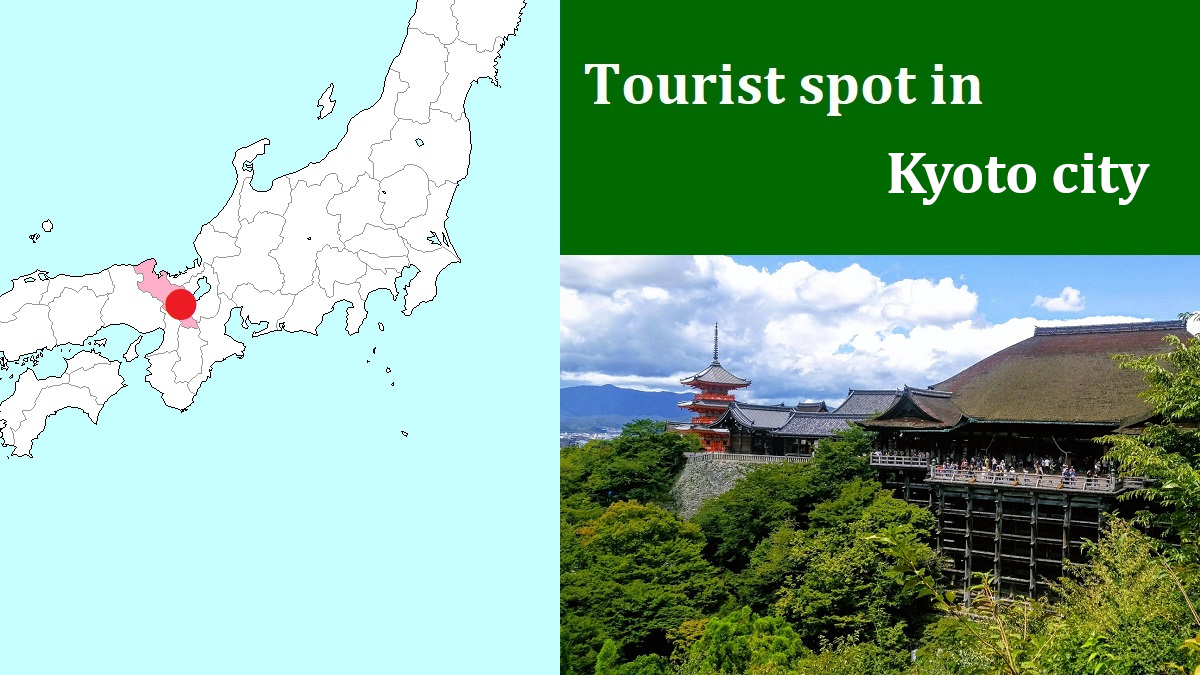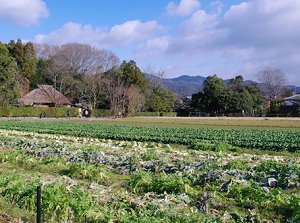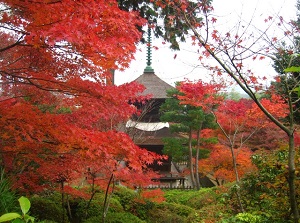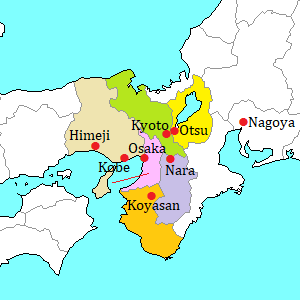Sagano district [嵯峨野]
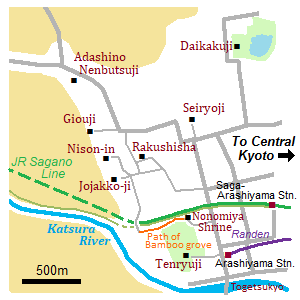
Sagano is the northern area of Arashiyama in the western suburbs of central Kyoto.
Basically, the area spreads to the north of JR Sagano Line.
It is about 3 km from east to west and about 2 km from north to south.
Since ancient times, here was a resort area of nobility.
Then their villas had been built, and most of them changed Buddhist temples over a long period of history.
So the temples are the sightseeing spots in this area.
These are dotted in the rural area surrounded by mountains.
Jôjakkô-ji (常寂光寺)
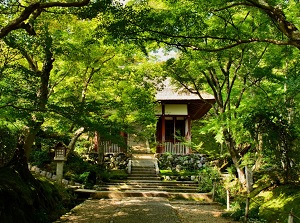
Jojakkoji in green leaves
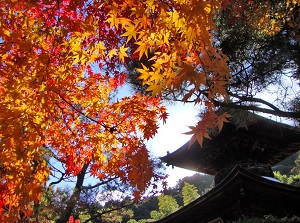
Two-story pagoda of Jojakkoji in autumn
Photo by Kyoto Free Photo
Jôjakkô-ji is a temple of Nichiren sect, one of the major sects of Buddhism.
It is located about 0.7 km northwest of Tenryuji temple in Arashiyama district.
It is on the mountainside of Mount Ogura (Ogurayama).
This temple was founded in 1596.
There are a few gates, the main temple and a two-story pagoda designated as an important cultural property.
It is a small temple, but about 200 maple trees are attractive.
So the colored leaves are popular.
Not only so, the green maple leaves from spring to summer are beautiful.
Nison-in (二尊院)
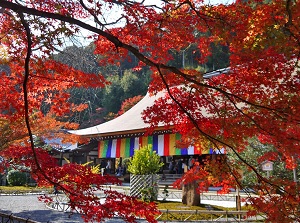
Main temple of Nison-in
Photo by Kyoto Free Photo
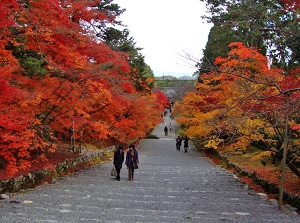
Momiji-no-Baba in Nison-in
Photo by Kyoto Free Photo
Nison-in is a temple of Tendai Buddhism which was introduced from China in the 8th century.
It is located about 0.3 km north of Tenryuji Jojakkoji.
It is also on the mountainside of Mount Ogura (Ogurayama).
This temple was founded by order of Emperor Saga in the around 840s.
The original temple was destroyed by fire in a civil war in 1467, then was restored in 1521.
"Nison" means "two holy gods", so Shaka-Nyorai Buddha and Amida-Nyorai Buddha are enshrined in the main hall.
Most attractive spot in this temple is the approach about 100 meters long.
It is called Momiji-no-Baba (Riding ground of maple leaves).
Along the approach, a lot of maple trees and cherry trees are planted, so cherry blossoms in spring and colored leaves in late autumn are very beautiful.
Rakushisha (落柿舎)
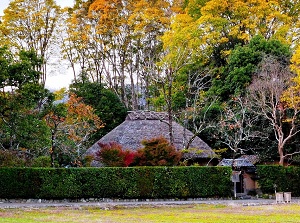
Rakushisha
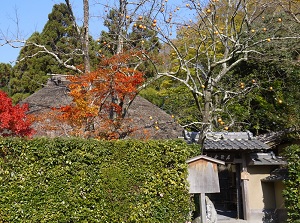
Persimmon tree in Rakushisha
Photo by Kyoto Free Photo
Rakushisha is an old thatched hut located about 250 meters east of Jojakko-ji temple.
It was built in the late 17th century and was rebuilt in 1770.
Mukai Kyorai (1651-1704) was a disciple of Matsuo Basho (1644-1689).
Basho was the greatest haiku poet, and he established haiku as an art of words.
("Haiku" is a short poem with only 17 Japanese syllables in three phrases, 5-7-5.)
Kyorai lived in this hut from around 1685, and his master Basho visited this hut a few times.
Since that, this hut has been preserved as a building related to haiku.
"Rakushi" means "fallen persimmon".
There are about 40 persimmon trees around the hut, and they bears a lot of fruits in autumn.
Giouji (祇王寺)
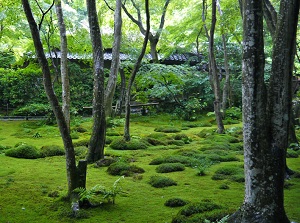
Garden covered with moss in Giouji
Photo by Kyoto Free Photo
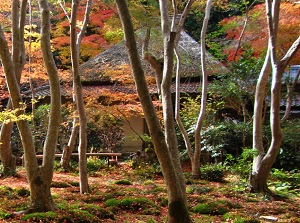
Main temple og Giouji in autumn
Photo by Kyoto Free Photo
Giouji is a small nunnery of Shingon Buddhism and is located about 350 meters northwest of Nison-in.
The original temple was founded in the 12th century, but had declined and abolished in the late 19th century.
In 1905, current temple was restored.
The temple is modest and is a small thatched hut.
the site is surrounded surrounded by a bamboo grove and maple trees.
Especially, the garden covered with moss is popular.
Adashino Nenbutsuji (化野念仏寺)
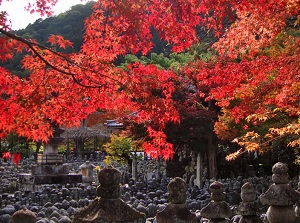
Adashino Nenbutsuji
Photo by Kyoto Free Photo
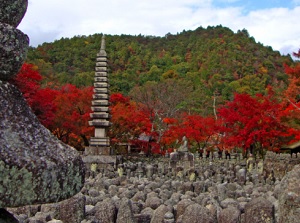
Sai-no-Kawara in Adashino Nenbutsuji
Photo by Kyoto Free Photo
Adashino Nenbutsuji is a temple of Pure Land Buddhism (Jodo-shu).
It is located about 0.6 km north of Giouji.
It is said that high priest Kuukai founded this temple to bury remains of the dead which had been left unattended in 811.
Later, high priest Honen opened a seminary of Buddhist invocation in this temple in the late 12th century.
In 1903, many neglected tombs around this area were gathered.
So the cemetery Sai-no-Kawara (西院の河原) is filled with over 8,000 stone Buddha statues and pagodas.
It is the most attractive place in this temple.
On August 23 and 24, "Sentou-kuyou" is held as the religious event.
In Sai-no-Kawara, a lot of candles for the 8,000 souls are lit in the evening.
In addition, we can take photos of Sai-no-Kawara from the outside of it, but it is not prohibited to take photos inside.
Seiryôji (清凉寺)
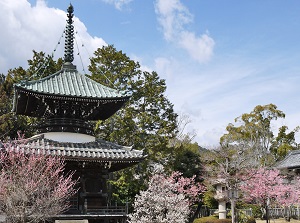
Seiryoji in spring
Photo by Kyoto Free Photo
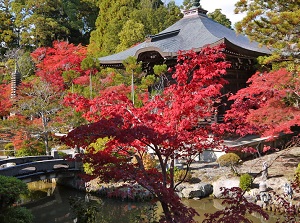
Seiryoji in autumn
Photo by Kyoto Free Photo
Seiryôji is a temple of Pure Land Buddhism (Jodo-shu).
It is located about 0.6 km east of Nison-in.
Buddha appeared in the 5th century B.C.
An Indian king ordered to carve a figure of real Buddha, and a statue was completed.
Later, another statue was carved after the model of the original statue, then it was in China.
When a priest visited China in 985, he also made a new statue carve after the model of the statue in China.
He brought back the statue to Japan, and built Seiryoji for the statue in 987.
The statue is enshrined in the main temple now, and is designated as a national treasure.
It is said that the figure is the living image of Buddha.
We can see only on the 8th day in every month and in April, May, October and November.
Daikakuji (大覚寺)
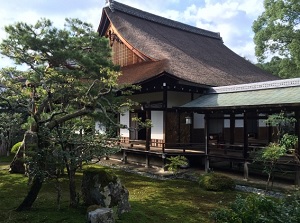
Shoshinden of Daikakuji
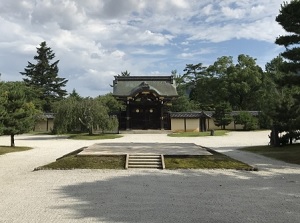
Garden in front of Shingyozenden
Daikakuji is a temple of Shingon Buddhism.
It is located about 0.8 km northeast of Seiryoji and about 1.2 km north of JR Saga-Arashiyama station.
Originally, there was the villa of C in the early 9th century.
Emperor Saga passed away in 842, and his princess changed the villa to Daikakuji temple in 876.
So many buildings in this temple are gorgeous.
There were rebuilt or added from the 17th to 20th centuries.
Shinden (宸殿) is the palace built in the early 17th century.
There are four rooms, and beautiful sliding screen paintings are in all rooms.
Other main buildings are Shingyôzenden (心経前殿) enshrining some statues of the emperors, Shôshinden (正寝殿) with 12 rooms, and Godaidou (五大堂).
These are connected by corridors, and visitors can see them along a regular route.
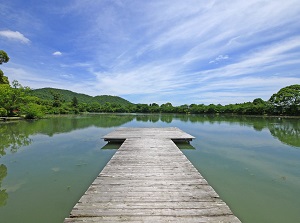
Osawa-no-Ike in Daikakuji
Photo by Kyoto Free Photo
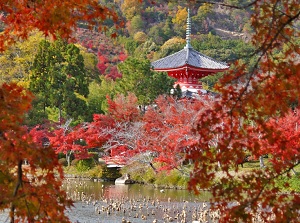
Daikakuji in autumn
Photo by Kyoto Free Photo
There is a large pond Ôsawa-no-Ike (大沢池) with about 1 km in circumference in the east half of the site.
It is said that this pond was built in the image of Lake Dongting in China by Emperor Saga.
How to get here
By Randen tram (Kitano Line of Keifuku Electric Railway), about 22 minutes from Kitano-Hakubaicho to Arashiyama terminal station.
Or, by rapid or local train on JR Sagano Line, about 14 to 20 minutes from Kyoto station to Saga-Arashiyama station.
There is a route bus stop in front of Randen Arashiyama station, but it is not so convenient to each spot.
You can visit each spot on foot.

